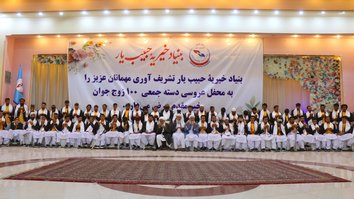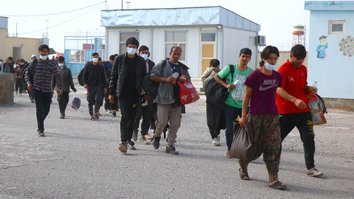KABUL -- Gunmen disguised as policemen stormed a television station in Kabul on Tuesday, killing at least two Afghans and wounding about two dozen others in the latest deadly attack targeting Afghan journalists.
The assault, claimed by the "Islamic State of Iraq and Syria" (ISIS), lasted about three hours before Afghan special forces overpowered the attackers, who were armed with guns and grenades, and freed staff trapped inside the building.
"The attack has ended. According to the commander of the special forces all the staff who were inside the building have been rescued," Shamshad TV announced as it went back on the air in an act of defiance just moments later.
"This is an attack on freedom of media, but they cannot silence us," Shamshad news director Abid Ehsas told rival TOLOnews at a hospital in Kabul where some of his wounded colleagues were being treated.
![Afghan security personnel take position after gunmen disguised as policemen stormed a television station in Kabul November 7. The gunmen killed at least two people. The assault lasted three hours before Afghan special forces overpowered the terrorists and freed staff trapped inside the building. [Shah Marai/AFP]](/cnmi_st/images/2017/11/07/10284-000_u23nk-585_329.jpg)
Afghan security personnel take position after gunmen disguised as policemen stormed a television station in Kabul November 7. The gunmen killed at least two people. The assault lasted three hours before Afghan special forces overpowered the terrorists and freed staff trapped inside the building. [Shah Marai/AFP]
The station reported that one attacker blew himself up at the gate. Another went inside and shot at staff before going up to the roof to fire at security forces.
A Shamshad news presenter, his hands bandaged after cutting his hands on glass as he fled the attackers, told viewers that 20 colleagues had been wounded, six critically.
"We have all come back [to work]; all our journalists and colleagues are back on duty," he said boldly.
Special forces had to blast their way through a wall of the compound to enter the premises of the Pashto-language broadcaster.
"I was in my office when gunmen wearing police uniforms attacked the building," Ehsas said.
"They killed one of our guards and entered the building and started firing. Most of us were able to flee, but some were wounded and some jumped out of the windows."
The station had not received any threats beforehand, he said.
Gunshots could be heard inside the building every few minutes during the assault as more and more security forces and emergency services swarmed the area.
At least one employee, Shamshad TV reporter Faisal Zaland, told AFP he had seen three attackers entering the building on security cameras.
The Afghan Journalists Safety Committee (AJSC) tweeted a call to "the government to take all preventive measures to protect" the media -- sentiments echoed by Amnesty International.
President Ashraf Ghani pledged to take "serious measures" to protect journalists in a denunciation of the attack.
Media under attack
ISIS claimed responsibility for the assault in a statement released by its Amaq propaganda agency. The Taliban had earlier released a Twitter statement denying involvement.
Kabul has been rocked by a series of deadly attacks in recent weeks as the Taliban and ISIS step up offensives against security installations and mosques.
The attack spotlighted the dangers faced by media workers in Afghanistan as security worsens. Violence against Afghan journalists surged in the first half of 2017, a media watchdog said in July.
Last year the country suffered its deadliest year on record for journalists, according to the AJSC, with at least 13 media workers killed -- 10 by the Taliban. That made it the second most dangerous place for reporters in the world after Syria.
In January 2016, seven employees of popular TV channel TOLOnews, which is often critical of the insurgents, were killed in a Taliban suicide bombing in Kabul in what the militant group said was revenge for "spreading propaganda" against them.
It was the first major attack on an Afghan media organisation since the Taliban were ousted from power in 2001.
Security in Kabul has been ramped up since a May 31 truck bomb exploded on the edge of the so-called "Green Zone", killing about 150 people.
That attack caused extensive damage to 1TV, a private news channel near the bombing site. Like Shamshad on Tuesday, it managed to resume operations within a few hours.
Special truck scanners, barriers and permanent and mobile checkpoints have been rolled out across the city since the May bombing. However, a suicide bomber struck again in Kabul's heavily fortified diplomatic quarter last week, killing at least five people.








Dear Editor, Good day. I am sorry to write that most of your reports show hatred and are biased against Pashtuns. Due to this, you consider Shamshad as the only Pashto language channel. There could be two reasons for this: 1) your reporters may not be Pashtun, and most of Tajiks and Hazaras hate Pashtuns. 2) Your news and reports' sources are either Tolonews or Khama Press and some of them are from Pajhwok. Tolonews is absolutely an anti-Pashtun media source and mostly broadcasts against Pashto and Pashtuns. You should keep balance in your news and reports so that Pashtun don't hate you. You should not broadcast the news of Tolonews as it is a disreputable network. You should use news and reports of televisions, radios and newspapers. If your news are not about Pashtun, then at least it should not be against them. Zhwandoon and Shamshad televisions are better than Tolonews in every aspect. Thanks!
Reply1 Comment